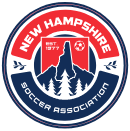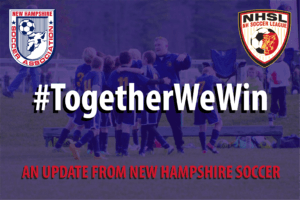NHSA: Return to Play Protocol
NOTE: As the State of New Hampshire actively makes updates and changes to their guidance to businesses and citizens, NHSA will actively seek to provide it’s members with updated information as it becomes available. Please bookmark this page for all of your latest information.
Introduction
The New Hampshire Soccer Association Return to Play Protocol is meant as a guide to return to the game of soccer in a safe and responsible manner, taking as many precautions as possible to limit and reduce the risk of infection of the Corona Virus. Following the Covid-19 Reopening Guidance published under Stay at Home 2.0 from the office of Governor Sununu, we have outlined this soccer-specific plan to guide our organizations as we return to play.
The information in this document is NOT intended or implied to be a substitute for professional medical advice, diagnosis, or treatment. All content and information is provided for general informational purposes only. The knowledge and circumstances around COVID-19 are changing constantly and, as such, the New Hampshire Soccer Association makes no representation and assumes no responsibility for the completeness of this information. Further, you should seek advice from medical professionals and/or public health officials in your area if you have specific questions. These guidelines address only early phases of return-to-play and additional guidelines may, or may not, follow as the COVID-19 pandemic continues to evolve.
Phases
The Guidelines set forth in the Stay at Home 2.0 Universal Guidelines establish a measured, gradual, game plan to return to normalcy. There are phases and stringent gating criteria that must be achieved before a State, a Region or, in this case, the New Hampshire Soccer Association can move from one phase to the next. Governor Sununu has extended the Stay at Home Order allowing some businesses to open while strongly recommending that the policies and procedures outlined by the order is followed. Although we can’t say with certainty when we can begin the next phase of this Return To Play Protocol, we feel it is important to know what it will look like and what we will need to do to prepare. By working together alongside our Federal, State and local governments, we can greatly reduce the time it takes to get back on the pitch.
Phase One
- Individual training sessions can be held in participant home/residence using his or her own equipment.
- Coaching occurs virtually. No coaches or athletes outside of the residence should be present during training.
Phase Two
Phase Two begins the gradual re-opening of many activities, but is, once again, limited by the ability to maintain control over the particular environment. We are all reminded that by returning to work or another activity, individuals could carry the virus back home to vulnerable individuals. Phase two calls for maximizing social distancing when in public and for avoiding groups of 10 or more in circumstances that do not readily allow for appropriate physical distancing. NHSA is interpreting Phase Two as permitting extremely limited activities so long as all possible measures are taken.
Activities permitted in Phase Two
- Practice/training sessions of single teams on each field. And no more than 25 players/coaches present on adjoining fields.
- Tryouts consisting of no more than 25 players/coaches present on adjoining fields.
Activities NOT permitted in Phase Two
These shall not be permitted because enforcing adherence to health safety protocols and guidelines is impossible.
- Games, scrimmages or friendlies.
- Tournaments or jamborees.
Limitations on Phase One Activities
Club Responsibilities
- Before a Club may begin to return to play, it must publish a notice to all players, parents and soccer families outlining the risks of returning and detailing how the Club intends to minimize or eradicate those risks.
- All return to play activities should be published as being voluntary. Clubs should be sensitive and accommodating to parents and players who may be uncomfortable with returning to play at this time.
- Clubs must provide hand sanitizer and/or washing stations and waste receptacles near each bench area.
- Clubs should organize “stations” for each player at or around the bench area observing social distance guidelines, which players can keep of their belongings. Players are encouraged to keep their water, snacks and equipment within their “station” and avoid touching someone else’s belongings.
- Before any and all activity (e.g. practice, tryout session, etc…) each individual and/or parent of individual should answer these questions
- Have you been in contact with a person with COVID 19?
- Have you had a cough, above normal temperature, or loss of taste or smell?
If anyone answers YES to any of these questions, they shall not be permitted to participate.
- Maintain participant confidentiality regarding health status.
Coach Responsibilities
- Activities should be limited in size (e.g. 3 v. 3 or 4 v. 4) so as to avoid large groups competing in a small space.
- It is highly recommended that activities last no more than one (1) hour. Fatigue brought on by physical activity renders an individual more vulnerable to the virus. Excessive activities, especially in the heat of the summer, should be avoided.
- Coaches alone shall be permitted to touch training equipment (discs, cones, etc.)
- If training bibs or pinnies are needed, players must bring their own colored shirts. For example, a coach should require each player to bring or wear a dark and a light t-shirt to play. If for any reason a training bib or pinnie is used by a player, it must be immediately isolated (put into a separate laundry bag) and not used again by any other individual unless and until it is laundered.
- Physical contact outside the game must be strictly avoided.
- Players must use their own soccer ball. There will be no throw-ins and no activity will include picking up a ball with your hands. Players will be discouraged from handling any soccer ball other than their own.
Player Responsibilities
- Players should wear masks prior to and immediately after training (if suggested under state/local authorities).
- Players should observe social distancing when not in play.
- Players shall be required to wash or sanitize their hands prior to and after training
- Players must wash their clothes immediately up returning home.
- Players must NOT share drinks, food, equipment or clothing at any time.
- Contact outside of play (e.g. high 5s, hugs, etc.) shall be avoided at all times.
Parents
- Parents should have hand sanitizer available for their children before and after each session.
- Parent shall remain in their cars during all activities. They may not congregate at or around the field. If they leave their car for any reason (e.g. to use a restroom) they must wear a face mask and observe social distancing if suggested under local/state guidelines.
- Should parents feel the need to communicate with a coach, it must be done via telecommunications or email.
- Parents should check player’s temperature before every activity. If the temperature is above normal, keep player home.
- Ensure your child’s clothes/equipment are clean and/or sanitized before every activity.
- Notify your club if your child becomes ill for any reason.
Phase Three (CURRENT PHASE)
Only after the Gateway Criteria are met in Phase Two, Phase Three will commence. Again, entering Phase Three is not accomplished by throwing a switch. It must be done responsibly given the nature of the soccer environment. The protocols set forth in Phase Two and before such as social distancing must not simply be abandoned.Activities permitted in Phase Three
- Practices of single teams on each field.
- Games, friendlies and scrimmages can be played.
- Tryouts can take place.
Activities NOT permitted in Phase Three
- Tournaments or jamborees outside of New England.
Tournaments pose a high risk because there is virtually no way to maintain control over protocol such as social distancing by and between players and supporters or spectators, and in many cases teams travel from outside New Hampshire. The tournament environment is essentially a petri dish in which the virus can flourish.




 NHSA MONTHLY BOARD MEETING FOR THE MONTH OF JULY 2024 POSTPONED – AUGUST MEETING 8/14/2024
NHSA MONTHLY BOARD MEETING FOR THE MONTH OF JULY 2024 POSTPONED – AUGUST MEETING 8/14/2024